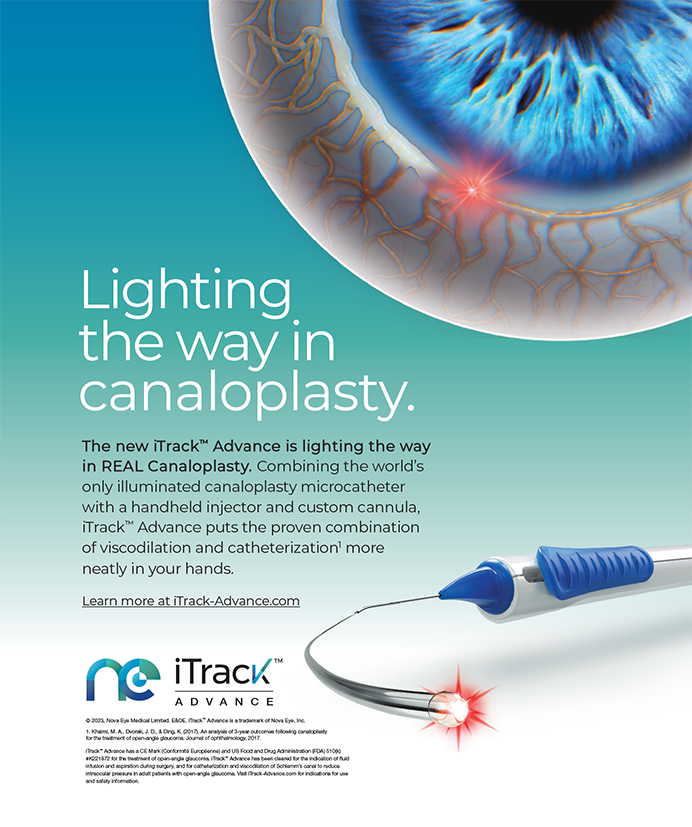Capsular block syndrome occurs in eyes with a continuous curvilinear capsulorhexis and is characterized by the accumulation of a liquefied substance within a closed chamber inside the capsule. This pool forms when the lens nucleus, or the PCIOL's optic, occludes the anterior capsular opening created by the continuous curvilinear capsulorhexis. My colleagues and I have proposed a new classification of capsular block syndrome to better understand the etiology of this complication and to provide effective treatment.1
Depending on its time of onset, capsular block syndrome can be classified as intraoperative capsular block syndrome (the complication seen at the time of lens luxation following hydrodissection),2 early postoperative capsular block syndrome (original capsular block syndrome3,4), and late postoperative capsular block syndrome (capsular block syndrome with liquefied after-cataract5,6 or lacteocrumenasia7). The etiology of the accumulated substance and method of treatment are different for each type. This article describes the intraoperative capsular block syndrome as a cause of dropped lens nuclei.
CASE REPORTSNo. 1
An 87-year-old female had a nuclear cataract in one eye that had a visual acuity of 20/400 and an axial length of 24.65mm. My colleagues and I injected 0.1mL of viscoelastic material into the anterior chamber and performed a standard continuous-tear capsulorhexis. Next, we gently injected 0.2mL of BSS between the lens capsule and the lens cortex with a 27-gauge needle, which we placed beneath the anterior lens capsule at the 11-o'clock meridian. After removing the epinucleus, we used the ultrasonic aspiration tip to sculpt the central portion of the nucleus. Immediately after the first sculpting, the entire nucleus dropped into the vitreous cavity.2
No. 2A 75-year-old male presented with a mature nuclear cataract and a visual acuity of hand motion in an eye with an axial length of 27.85mm. We performed a continuous-tear capsulorhexis and hydrodissection in the same manner as described in the aforementioned case. Immediately after the removal of the epinucleus on the anterior surface, the nucleus slipped down into the vitreous cavity.2
No. 3An 83-year-old female presented with a mature nuclear cataract. She had a visual acuity of hand motion and an axial length of 21.07mm in this eye. Her contralateral, untreated eye showed evidence of pseudoexfoliation syndrome, including white flakes at the pupillary margin and on the anterior lens capsule. The treated eye, however, disclosed no such findings. We performed a continuous-tear capsulorhexis and hydrodissection. Again, immediately after hydrodissection, the nucleus dropped into the vitreous cavity.
No. 4An 85-year-old male with a nuclear cataract had a visual acuity of 20/67 in an eye with an axial length of 28.32mm. Again, we performed a continuous-tear capsulorhexis and hydrodissection. On removal of the epinucleus from the anterior surface, the nucleus descended into the vitreous cavity.
COMMENTSIntraoperative capsular block syndrome occurs in eyes with a posterior capsular rupture and a luxated nucleus following continuous curvilinear capsulorhexis and hydrodissection. This type of capsular block syndrome is caused by rapid hydrodissection using a large amount of BSS. The eye becomes especially vulnerable when a highly viscous viscoelastic material is injected into the anterior chamber prior to hydrodissection. The phenomenon is common in eyes with a posterior polar or mature cataract and in those with a long visual axis. The nucleus occludes the anterior capsular opening created by the continuous curvilinear capsulorhexis as a result of capsular blockage, and the trapped BSS expands toward the posterior capsule, which the fluid inflates completely and pushes anteriorly. The anterior chamber becomes shallow, and the IOP rises. In the worst cases, the posterior capsule ruptures, and the nucleus luxates into the vitreous cavity. The BSS that flows into the vitreous cavity through the ruptured posterior capsule may also contribute to an anterior shifting of the capsular bag (Figure 1).
In many eyes with intraoperative capsular block syndrome, the shallow anterior chamber makes it difficult to insert the phaco tip. The nucleus luxates as the epinucleus is removed with an ultrasound tip; in some cases, the luxation of the nucleus occurs during phacoemulsification of the nucleus or during nuclear division. To prevent these complications, hydrodissection should be performed with great caution or avoided in eyes suspected of having a weakened posterior capsule. I also recommend using a large-gauge cannula and depressing the posterior lip of the incision while performing hydrodissection. The latter prevents a high spike in IOP during this phase.
Kensaku Miyake, MD, is Director and Head of the Shohzankai Medical Foundation at Miyake Eye Hospital in Nagoya, Japan. He states that he holds no financial interest in any product or company mentioned herein. Dr. Miyake may be reached at 81 52 91 58 001; miyake@spice.or.jp.1. Miyake K, Ota I, Ichihashi S, et al. New classification of capsular block syndrome. J Cataract Refract Surg. 1998;24:1230-1234.
2. Ota I, Miyake S, Miyake K. Dislocation of the lens nucleus into the vitreous cavity after standard hydrodissection. Am J Ophthalmol. 1996;121:706-708.
3. Davison JA. Capsular bag distension after endophacoemulsification and posterior chamber intraocular lens implantation. J Cataract Refract Surg. 1990;16:99-108.
4. Holtz SJ. Postoperative capsular bag distension. J Cataract Refract Surg. 1992;18:310-317.
5. Ota I, Miyake S, Miyake K. Whitish liquefied after cataract: a preliminary report. Jpn J Ophthalmic Surg. 1997;10:353-357.
6. Miyake K, Ota I, Miyake S. Liquefied after cataract: a complication of continuous curvilinear capsulorhexis and intraocular lens implantation in the lens capsule. Am J Ophthalmol. 1998;125:429-435.
7. Eifrig DE. Capsulorhexis-related lacteocrumenasia. J Cataract Refract Surg. 1997;23:450-454.
For a downloadable pdf of this article, including Tables and Figures, click here.


